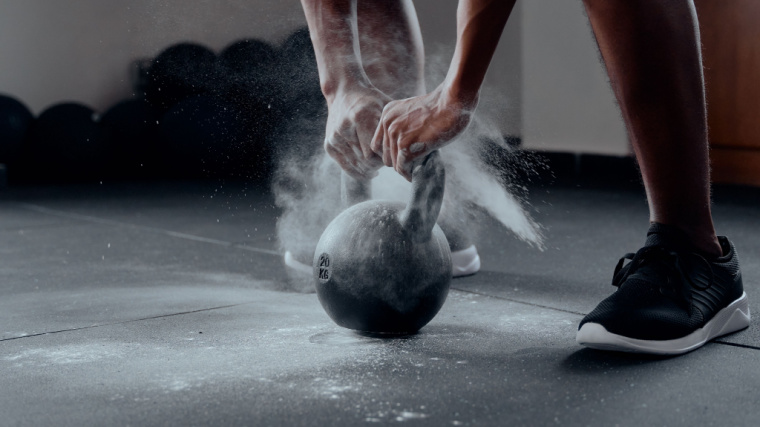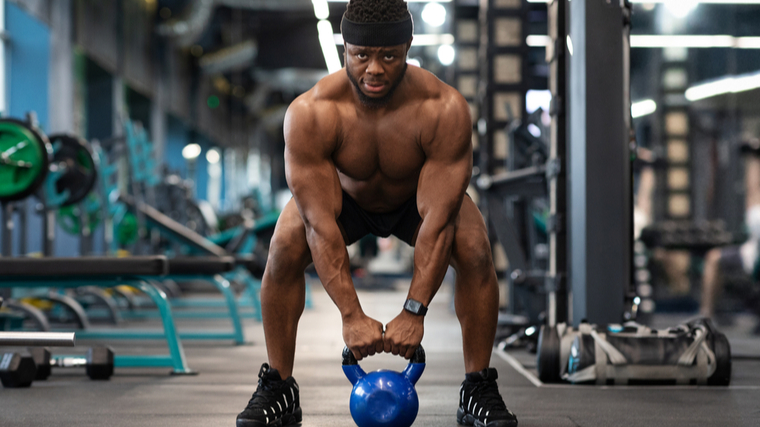The glutes are your body’s center of power, and nothing builds the glutes like the hip hinge. The hip hinge forms the foundation of a lot of strength and athletic moves, and two fantastic hinge exercises are the cable pull-through and the kettlebell swing. But which one should you choose and why?
Both the cable pull-through and the kettlebell swing train and develop your posterior chain and hip hinge. Moreover, both can help you develop lower body power and conditioning.

While both movements are similar, there are differences in stability, setup, and technique that may have you prefer one over the other. Depending on your goals, the cable pull-through or the kettlebell swing might work better for you. It’s up to you and your preferences. But with some guidance below, you can determine whether using either a cable pull-through or the kettlebell swing is best.
Differences Between the Cable Pull-Through and Kettlebell Swing
Let’s get this out of the way first — the cable pull-through and the kettlebell swing are both hip hinge exercises that you can perform for hypertrophy, strength, and power. But that doesn’t make them the same. Here are some of the key differences between the two.
Rep Speed
The biggest difference between the cable pull-through and the kettlebell swing is the way it is performed. The cable pull-through is performed with controlled tempo to maintain muscular tension throughout the range of motion.
However, the kettlebell swing is a power-based movement that is performed ballistically, and the goal of every rep is to bang it out explosively.
Muscles Trained
The cable pull-through with the load behind you encourages you to sink into your hips, improving your hip mobility while taking some stress off the lower back.
[Read More: Best Lower Back Exercises for Strength and Reduced Pain]
It targets the glutes and hamstring but not the lower back. While the kettlebell swing targets more of your lower back, due to the weight dynamically shifting forward and backward during each repetition and the stability requirement of keeping a neutral spine at speed.
Setup
With the kettlebell swing, you need to address the kettlebell that’s in front and start with it on the floor. Not so with the cable pull-through. You need a cable machine, and rope attachment and acknowledge that the resistance begins behind you.
Plus, you start from a standing position and lower into an eccentric contraction, which is opposite of the kettlebell swing.
Complexity
The cable pull-through is a less complex movement, period. Due to the lower rep speed, as well as the assisted movement patterning caused by the pull of the cable behind you, this is a key movement prep exercise for beginners to master the hip hinge and posterior loading movement.
Kettlebells, while simplistic in design, require much more coordination, proprioception, muscle and connective tissue elasticity, and proper firing of the entire posterior chain to properly utilize.
Similarities Between the Cable Pull-Through and Kettlebell Swing
The cable pull-through and the kettlebell swing might not be performed the same and the setup is different, however, they’ve still got some similarities too.
Movement Pattern
The repetition speed and load of the cable pull-through and kettlebell swing are different due to the setup but the overall movement pattern is the same.
Both the cable pull-through and the kettlebell swing are pure hip hinge exercises. If you were to remove the equipment from each, the way your body moves would be indiscernibly similar, at least from the waist down.
Both Build the Posterior Chain
The cable pull-through and the kettlebell swing both train your posterior chain. Though the kettlebell swing may work your back harder, the cable pull-through still trains your lower back to a certain extent.
The kettlebell swing builds explosive strength in your glutes and hamstrings and the cable pull-through helps build muscle and hip hinge form. Both the cable pull-through and kettlebell swing require a good amount of grip strength as you’re holding onto a weight for long periods of time.
Cable Pull-Through vs. Kettlebell Swing Technique
Though the technique for the cable pull-through and the kettlebell swing are similar, there are differences in setup and performance.
Setup and Tension
The cable pull-through has constant tension applied to the target muscles, and you perform it at a slower rep speed throughout the range of motion which is suitable for building muscle and reinforcing good hip hinge mechanics. Because the load is behind you, it assists you in sinking into your hip hinge.
While a swinging kettlebell will also help “pull” you into a hinged position, the weight begins in front of your body. So, you have to initiate the pendulum-swing effect manually. The bell is only as good as helping you hinge as you are at thrusting it.
How to Do the Cable Pull-Through
While it may sound simple on paper, you might need a convenient step-by-step explanation of the cable pull-through to fully get the hang of it. Here’s how to get it right.
- Attach a rope to the cable machine at its lowest setting.
- Then turn around and face away from the machine with the rope attachment between your legs and palms facing each other.
- Take a few steps away from the machine until you feel the tension in your hands and glutes.
- Set your feet hip-width apart and hinge back slowly until you feel a stretch in your hamstrings while keeping a neutral spine.
- Reverse the movement, squeezing your glutes at lockout. Reset and repeat.
How to Do the Kettlebell Swing
The kettlebell swing does provide a lot of tactile assistance with the form — once the bell is already in motion. However, getting started can be the trickiest part of the whole thing.
- Stand with your feet wider than shoulder-width apart, with the kettlebell in front of you.
- Hinge down to grip the kettlebell and squeeze your armpits and get your chest up.
- Hike the kettlebell behind you and thrust your hips forward, using this momentum to swing the kettlebell up.
- Finish by squeezing your glutes and quads. Your body should be in a straight line from head to toe.
- Repeat in a continuous loop for reps.
When to Do the Cable Pull-Through vs. Kettlebell Swing
When you want a posterior of steel both these exercises deserve a spot in programming. But if you’re trying to figure out which one is best for you, be guided by the advice below.
For Strength
Neither is the best exercise when it comes to hip hinge strength. The title belongs to the deadlift and its variations. But when it comes to moving the most weight possible, through the biggest range of motion, this will happen with the cable pull-through. But this depends on how high the cable stack goes. Yes, kettlebells do go heavier but grip strength and range of motion become issues.
If you’re looking to build posterior strength and power, the kettlebell swing should be your go-to. The ballistic nature of the kettlebell swing improves your power and trains the fast twitch muscle fibers which have the biggest potential for muscle and strength improvements.
For Body Composition
When you’re looking to drop fat and build muscle, the kettlebell swing is your best option. The swing is an ideal mix of strength and cardio which will have you sucking in air and burning calories.
But the cable pull-through shouldn’t be discounted because of your ability to train it higher reps for glute and hamstring hypertrophy.

That said, both are good choices for muscle growth and fat loss because they work similar muscles. The cable pull-through provides constant tension and a larger range of motion while the kettlebell fires up your fast twitch muscle fibers which have the bigger potential for growth.
However, understand that the most integral factor regarding whether you gain or lose body fat will be your caloric deficit. There’s no movement you can perform inside or outside of a gym that will work as potently as properly managing your energy balance.
For Bodybuilders
Bodybuilders will probably benefit more from the cable pull-through than the kettlebell swing. You might be able to recover faster from the cable pull-through as well because you can finely control the resistance and tempo of the exercise.
Although the kettlebell swing is still a great exercise and “sets the table” for fat loss, it can be hard on the lower back and can impact recovery, especially when you train the lower body frequently.
For Beginners
Before even attempting the kettlebell swing, you have to be proficient at deadlifting. Whether being a barbell deadlift or one if its many variations, learning to hip hinge before moving to something fast like the swing takes time and effort. For beginners, starting with the cable pull-through is a better option.
The increased stability and less stress on the lower back help you build confidence with the hip hinge pattern before moving to something that’s faster like the swing. Once you’re comfortable bending and extending your hips with some resistance present, you can move to a free-weight exercise like the swing.
Cable Pull-Through vs. Kettlebell Swing — Who Wins?
Both are great exercises that train the glutes and hamstrings, generally with higher repetitions, and both can have a place in your program. When you’re looking to improve your glute lockout strength and speed off the floor for the deadlift, then the kettlebell swing should be your go-to. Locking your glutes with a kettlebell will simulate what it feels like to lock out a barbell deadlift.
If you’re a bodybuilder, suffer from lower back pain, or are learning the hip hinge for the first time, you should probably consider making the pull-through your main movement for its ease of access. Beyond that, which exercise you enjoy and benefit most from is largely a personal preference.
Featured Image: Vladimir Sukhachev / Shutterstock